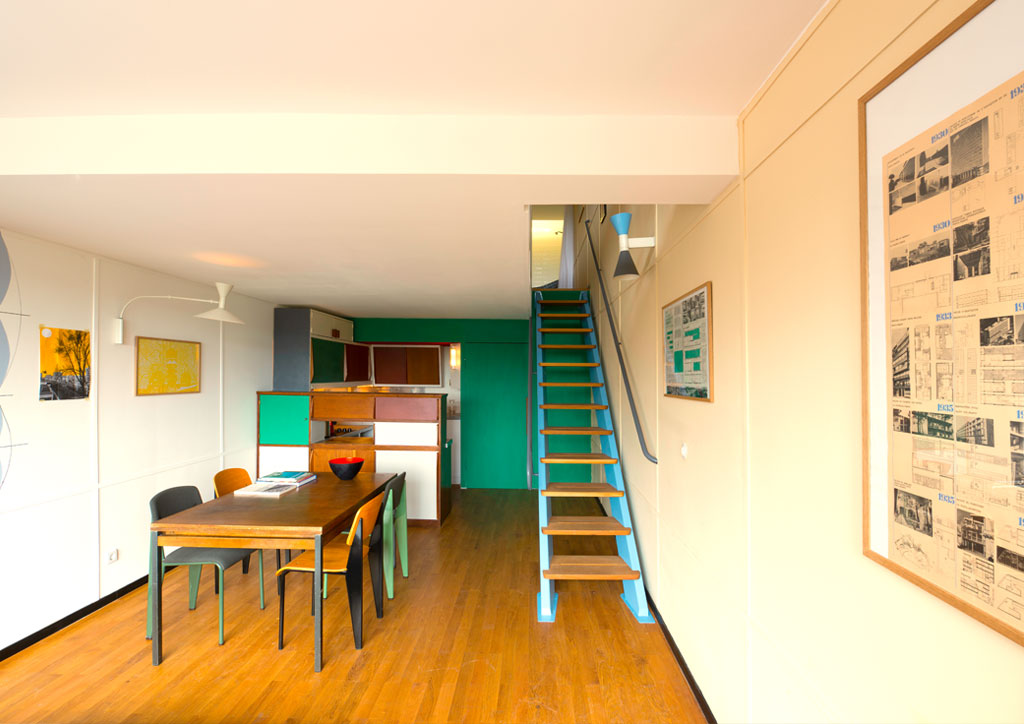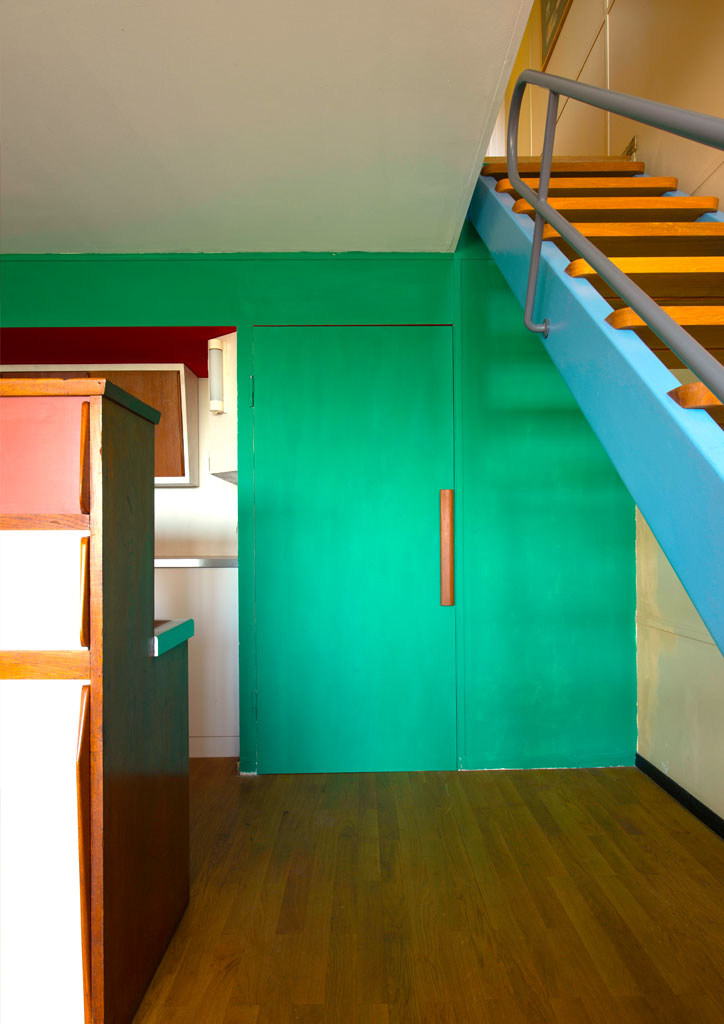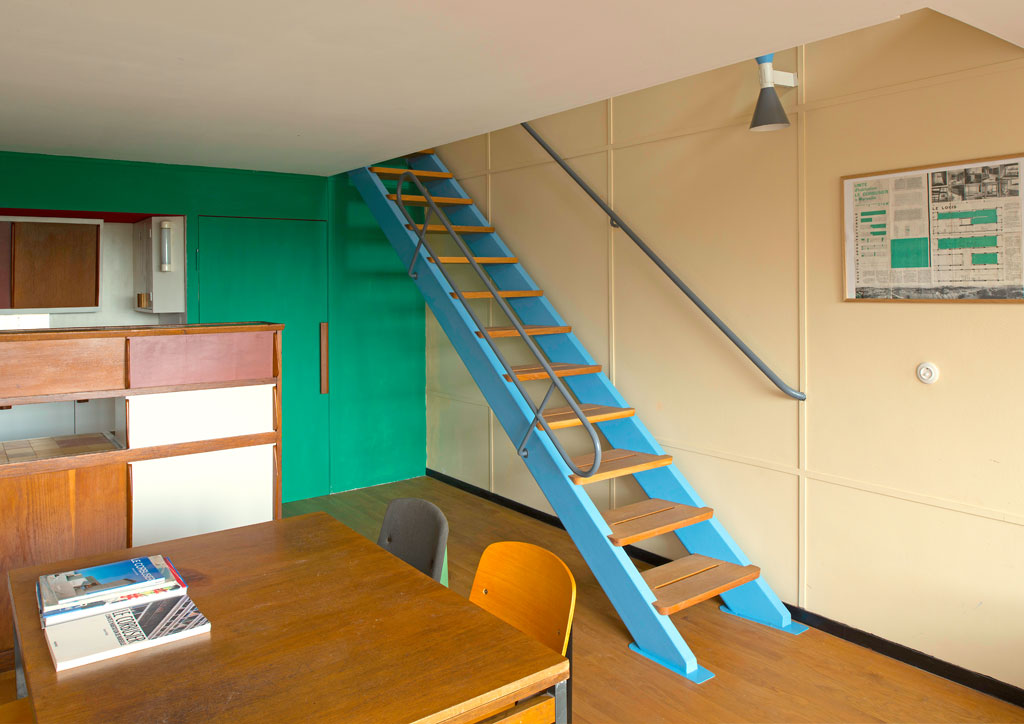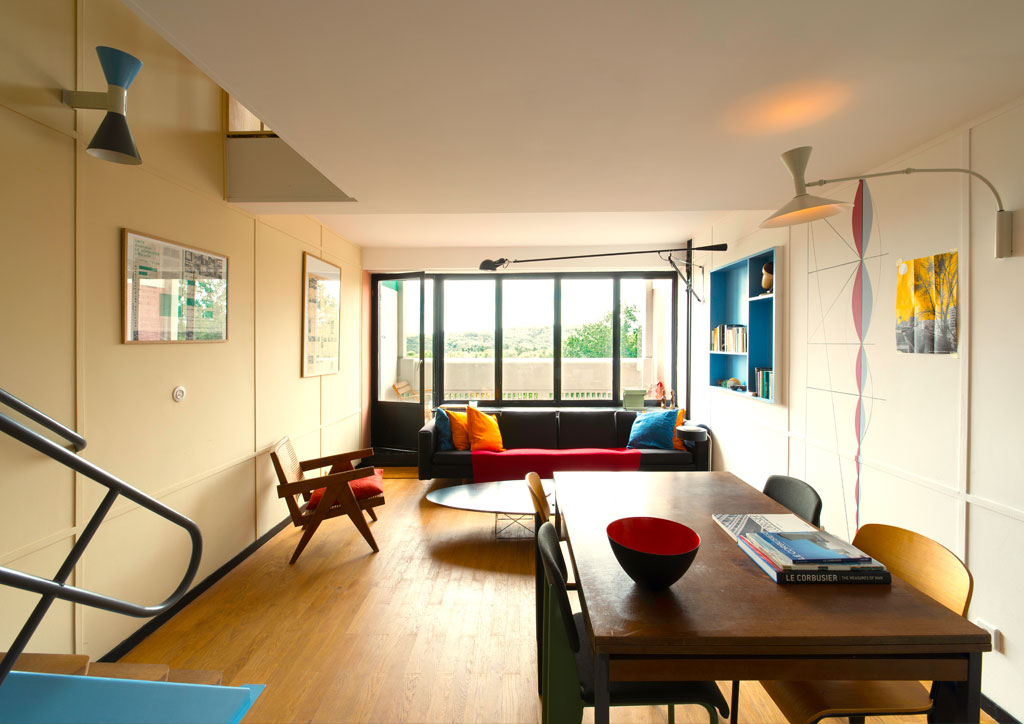
The interplay of colors inside Philipp Mohr’s faithful renovation of a Le Corbusier apartment

A lilt that swells into an entire orchestra of puristic and intensive shades greets the eyes if one were to enter the Le Corbusier apartment in Berlin, like the arresting jade in the kitchen area interrupted by the restrained blue stair stringer against a cream wall.
Raised in West Germany, architect Philipp Mohr has always displayed a fondness for the Bauhaus aesthetic, howbeit the decline of modernist buildings in the late 1990s. Mohr presently heads the Philipp Mohr Design Studio, a Berlin and Brooklyn-based creative collective of visionaries with an ambit of architects, artists, copyrighters, and designers. He pursued his studies at the Bauhaus School in Weimar, and was riveted by Charles-Édouard Jeanneret (or commonly known as Le Corbusier) after taking part in a retrospective exhibition as a teenager in the 1980s. It was also around this time, specifically in 1989, when he first visited one of the Le Corbusier apartments in the Unité d’Habitation building, which he purchased later on in 2016 with the purpose of selling it right after a refurbishment. A humble two-level unit was secured eventually.

An utterly polemical designer, Le Corbusier was raised in a modernized city in the Swiss mountains. The blocks where he lived in conformed to the same size, and houses possessed the identical ratio of free space, green space, street and built areas. Corbusier was familiar with this rapport of the built environment, as well as the exposure to the sun. These then became into a central theme expressed in his architecture and residential interiors.


After its erection in 1958, the interior plan of the Brutalist Unité d’Habitation building was significantly altered following a dispute between Le Corbusier and the local planning authorities. When Mohr bought the apartment, the interior exhibited a faint resemblance to the way Corbusier intended it. It took after many other standard low-cost apartments in Berlin, even bringing to mind images of a prison and its dreaded monotony. Because of this, Mohr sought a refurbishment that is in line with Corbusier’s original design.
Sufficient research at the Fondation Le Corbusier and the Cité de l’Architecture et du Patrimoine in Paris enabled Mohr to establish the building’s interior. Along with his findings is the realization that there had been plans for the Berlin apartments, and that the interior was not drawn by Le Corbusier or his designers at all. German architects from Berlin were the ones in charge of drawing their own interiors that fitted the planning criteria within the carapace of Corbusier’s building. The product was not anymore proportionate, thus, affecting the mood, quality, and function of the interiors. Mohr read about almost everything written on Le Corbusier, which resulted in a physical work on the apartment. In the course of this, he stumbled upon two original pieces from the Marseille building, a kitchen counter and a fragment of a staircase. Other furniture pieces like lamps, chairs, and tables followed suit, as the objective was to refashion what would have been in Corbusier’s mind.

The Unité d’Habitation building is considered as one of the most instrumental Brutalist buildings of all time. It was established as a new typology for affordable housing that offered amply proportioned dual-aspect living spaces fenced in a communal parkland. “The efficiency of the building and the apartment in the building are very environmentally conscious. Instead of wasting a lot of natural ground and destroying nature, Le Corbusier proposed not to destroy and occupy the ground, but to put the building on columns and let nature continue on the land. The area around the building is mostly green and planted with trees,” Philipp Mohr Design Studio tells BluPrint.


Mohr began the renovation by lowering the ceiling height and moving walls to procreate the envisioned layout and proportions after having entirely gutted the interior. The existing chairs and kitchen were removed and swapped with original versions that were bought at an auction, together with new parts that were reconstructed based on the original plans. He completed the interior by sourcing furniture and lighting created by Corbusier himself. Despite the fact that these were not authentic to the original apartment, the furniture still harmonize with the period in which Corbusier developed the plans.

The color scheme that dresses the whole apartment was sensibly chosen based on research into Corbusier’s writings about color theory. Some of the paint colors—those that are exceedingly architectural, effortlessly symphonic, and can be combined in any way—were developed by Corbusier himself. The colors embody spatial and human effects, and are relevantly grounded. “Color in architecture—a means as powerful as the ground plan and section. Or better: polychromy, a component of the ground plan and the section itself,” states the man behind the notable color board.
In 2016, the year Mohr purchased the two-level apartment, UNESCO added 17 of Corbusier’s projects, including the Unité d’Habitation building, to its list of internationally momentous architecture sites. Despite its modest size, the Le Corbusier apartment in Berlin has certainly reached its desired completion, due to Mohr’s faithful renovation under the sway of sheer passion. ![]()


READ MORE: WOHA unveils the urban hub Design Orchard to the public


